2014 NISSAN XTERRA brake light
[x] Cancel search: brake lightPage 341 of 384
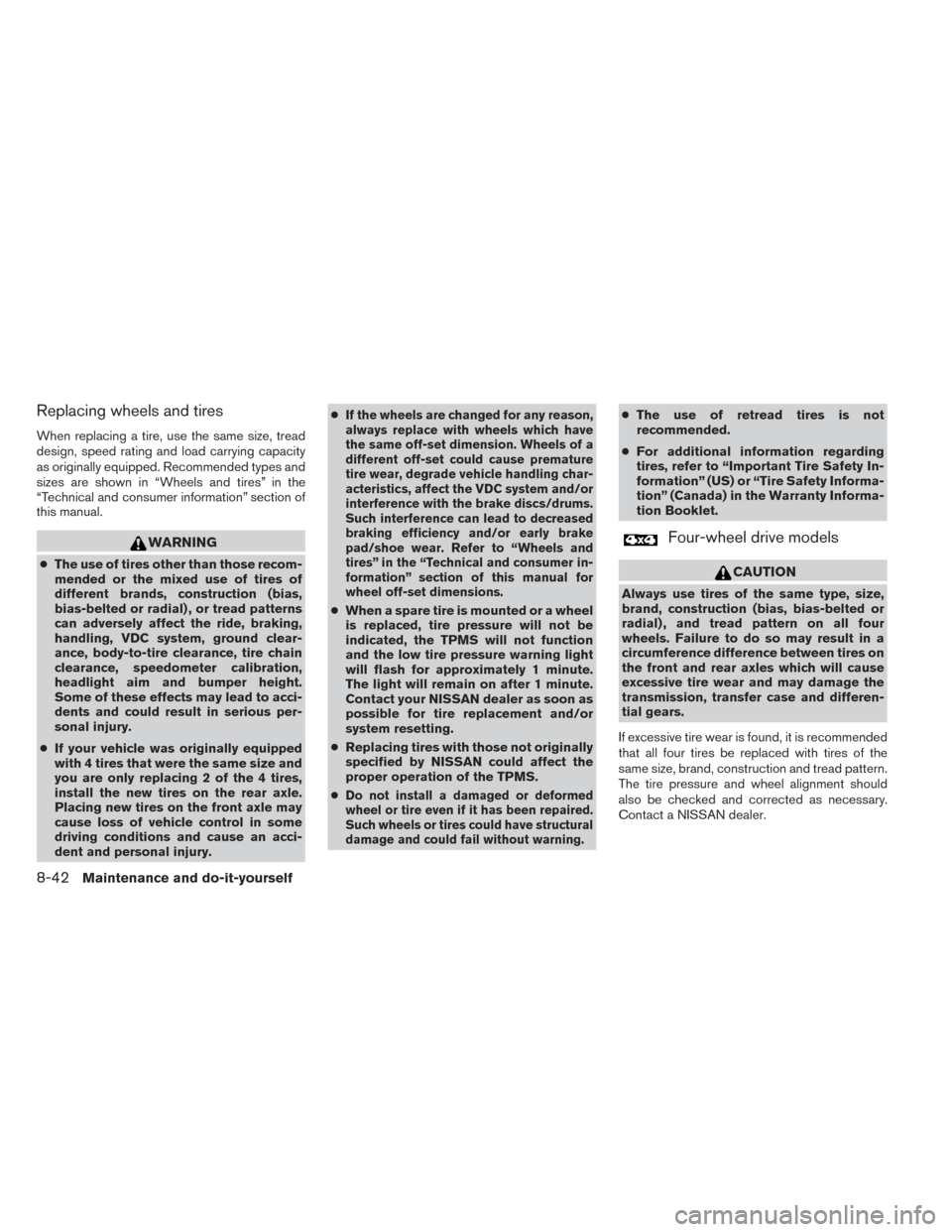
Replacing wheels and tires
When replacing a tire, use the same size, tread
design, speed rating and load carrying capacity
as originally equipped. Recommended types and
sizes are shown in “Wheels and tires” in the
“Technical and consumer information” section of
this manual.
WARNING
●The use of tires other than those recom-
mended or the mixed use of tires of
different brands, construction (bias,
bias-belted or radial) , or tread patterns
can adversely affect the ride, braking,
handling, VDC system, ground clear-
ance, body-to-tire clearance, tire chain
clearance, speedometer calibration,
headlight aim and bumper height.
Some of these effects may lead to acci-
dents and could result in serious per-
sonal injury.
● If your vehicle was originally equipped
with 4 tires that were the same size and
you are only replacing 2 of the 4 tires,
install the new tires on the rear axle.
Placing new tires on the front axle may
cause loss of vehicle control in some
driving conditions and cause an acci-
dent and personal injury. ●
If the wheels are changed for any reason,
always replace with wheels which have
the same off-set dimension. Wheels of a
different off-set could cause premature
tire wear, degrade vehicle handling char-
acteristics, affect the VDC system and/or
interference with the brake discs/drums.
Such interference can lead to decreased
braking efficiency and/or early brake
pad/shoe wear. Refer to “Wheels and
tires” in the “Technical and consumer in-
formation” section of this manual for
wheel off-set dimensions.
● When a spare tire is mounted or a wheel
is replaced, tire pressure will not be
indicated, the TPMS will not function
and the low tire pressure warning light
will flash for approximately 1 minute.
The light will remain on after 1 minute.
Contact your NISSAN dealer as soon as
possible for tire replacement and/or
system resetting.
● Replacing tires with those not originally
specified by NISSAN could affect the
proper operation of the TPMS.
●
Do not install a damaged or deformed
wheel or tire even if it has been repaired.
Such wheels or tires could have structural
damage and could fail without warning.
● The use of retread tires is not
recommended.
● For additional information regarding
tires, refer to “Important Tire Safety In-
formation” (US) or “Tire Safety Informa-
tion” (Canada) in the Warranty Informa-
tion Booklet.
Four-wheel drive models
CAUTION
Always use tires of the same type, size,
brand, construction (bias, bias-belted or
radial) , and tread pattern on all four
wheels. Failure to do so may result in a
circumference difference between tires on
the front and rear axles which will cause
excessive tire wear and may damage the
transmission, transfer case and differen-
tial gears.
If excessive tire wear is found, it is recommended
that all four tires be replaced with tires of the
same size, brand, construction and tread pattern.
The tire pressure and wheel alignment should
also be checked and corrected as necessary.
Contact a NISSAN dealer.
8-42Maintenance and do-it-yourself
Page 368 of 384
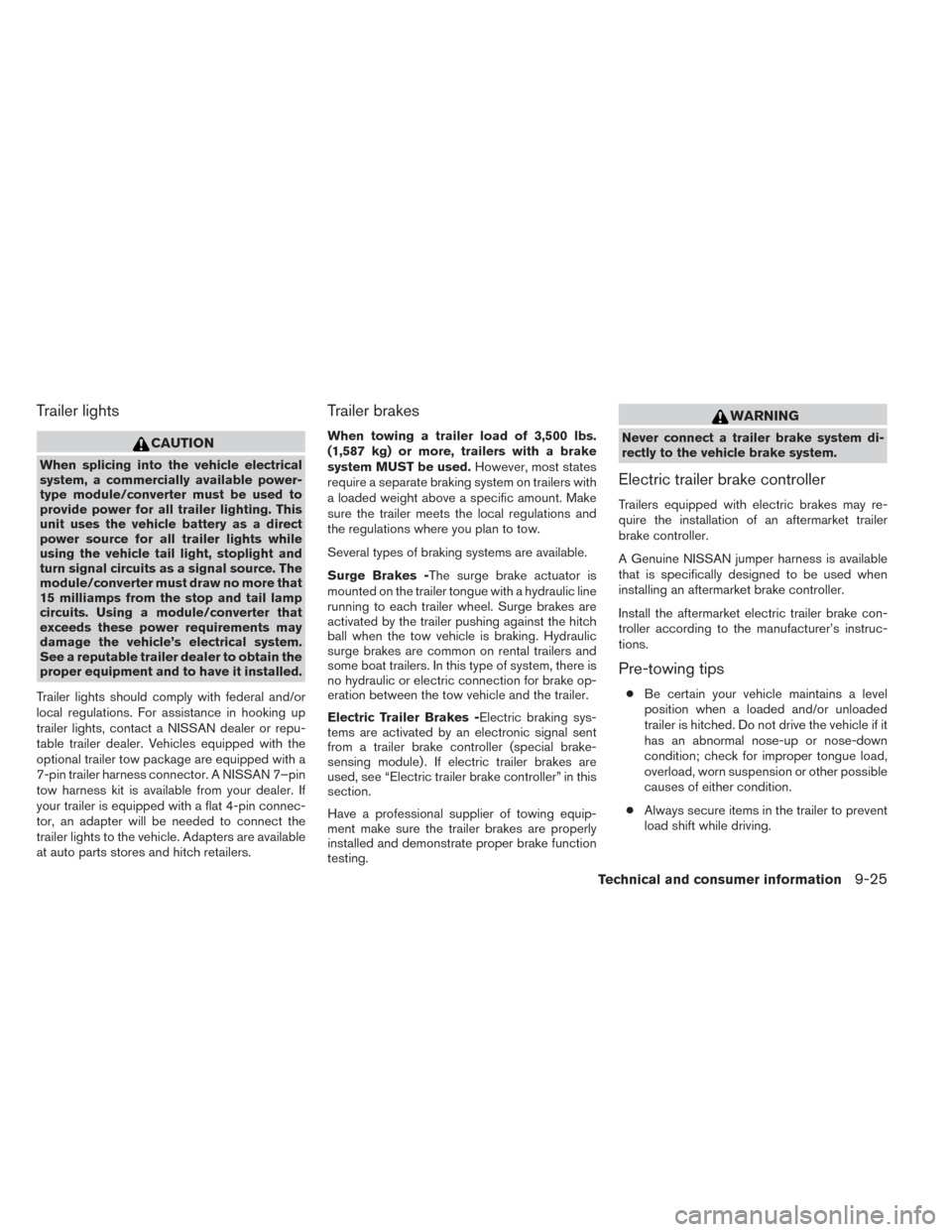
Trailer lights
CAUTION
When splicing into the vehicle electrical
system, a commercially available power-
type module/converter must be used to
provide power for all trailer lighting. This
unit uses the vehicle battery as a direct
power source for all trailer lights while
using the vehicle tail light, stoplight and
turn signal circuits as a signal source. The
module/converter must draw no more that
15 milliamps from the stop and tail lamp
circuits. Using a module/converter that
exceeds these power requirements may
damage the vehicle’s electrical system.
See a reputable trailer dealer to obtain the
proper equipment and to have it installed.
Trailer lights should comply with federal and/or
local regulations. For assistance in hooking up
trailer lights, contact a NISSAN dealer or repu-
table trailer dealer. Vehicles equipped with the
optional trailer tow package are equipped with a
7-pin trailer harness connector. A NISSAN 7–pin
tow harness kit is available from your dealer. If
your trailer is equipped with a flat 4-pin connec-
tor, an adapter will be needed to connect the
trailer lights to the vehicle. Adapters are available
at auto parts stores and hitch retailers.
Trailer brakes
When towing a trailer load of 3,500 lbs.
(1,587 kg) or more, trailers with a brake
system MUST be used. However, most states
require a separate braking system on trailers with
a loaded weight above a specific amount. Make
sure the trailer meets the local regulations and
the regulations where you plan to tow.
Several types of braking systems are available.
Surge Brakes -The surge brake actuator is
mounted on the trailer tongue with a hydraulic line
running to each trailer wheel. Surge brakes are
activated by the trailer pushing against the hitch
ball when the tow vehicle is braking. Hydraulic
surge brakes are common on rental trailers and
some boat trailers. In this type of system, there is
no hydraulic or electric connection for brake op-
eration between the tow vehicle and the trailer.
Electric Trailer Brakes -Electric braking sys-
tems are activated by an electronic signal sent
from a trailer brake controller (special brake-
sensing module) . If electric trailer brakes are
used, see “Electric trailer brake controller” in this
section.
Have a professional supplier of towing equip-
ment make sure the trailer brakes are properly
installed and demonstrate proper brake function
testing.
WARNING
Never connect a trailer brake system di-
rectly to the vehicle brake system.
Electric trailer brake controller
Trailers equipped with electric brakes may re-
quire the installation of an aftermarket trailer
brake controller.
A Genuine NISSAN jumper harness is available
that is specifically designed to be used when
installing an aftermarket brake controller.
Install the aftermarket electric trailer brake con-
troller according to the manufacturer’s instruc-
tions.
Pre-towing tips
● Be certain your vehicle maintains a level
position when a loaded and/or unloaded
trailer is hitched. Do not drive the vehicle if it
has an abnormal nose-up or nose-down
condition; check for improper tongue load,
overload, worn suspension or other possible
causes of either condition.
● Always secure items in the trailer to prevent
load shift while driving.
Technical and consumer information9-25
Page 369 of 384
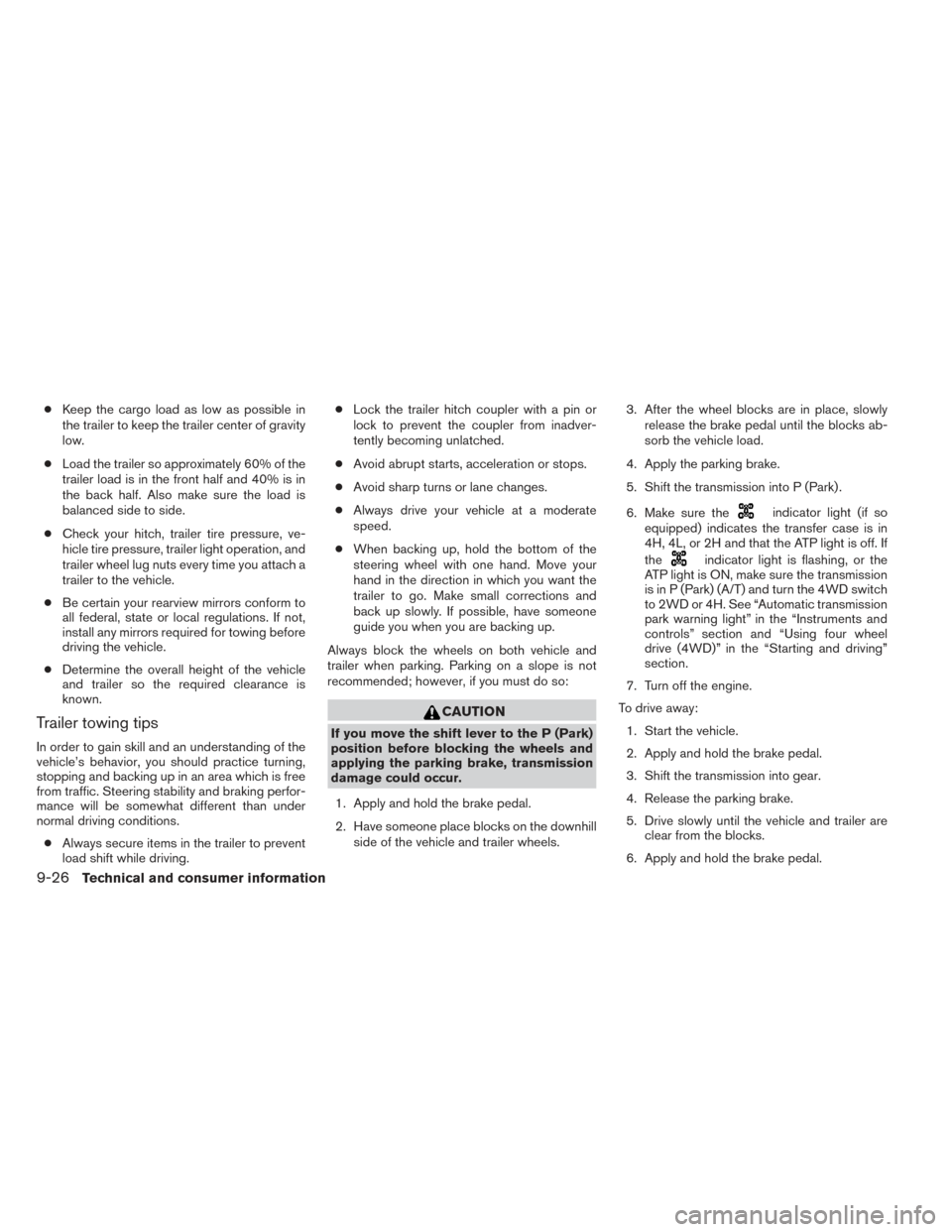
●Keep the cargo load as low as possible in
the trailer to keep the trailer center of gravity
low.
● Load the trailer so approximately 60% of the
trailer load is in the front half and 40% is in
the back half. Also make sure the load is
balanced side to side.
● Check your hitch, trailer tire pressure, ve-
hicle tire pressure, trailer light operation, and
trailer wheel lug nuts every time you attach a
trailer to the vehicle.
● Be certain your rearview mirrors conform to
all federal, state or local regulations. If not,
install any mirrors required for towing before
driving the vehicle.
● Determine the overall height of the vehicle
and trailer so the required clearance is
known.
Trailer towing tips
In order to gain skill and an understanding of the
vehicle’s behavior, you should practice turning,
stopping and backing up in an area which is free
from traffic. Steering stability and braking perfor-
mance will be somewhat different than under
normal driving conditions.
● Always secure items in the trailer to prevent
load shift while driving. ●
Lock the trailer hitch coupler with a pin or
lock to prevent the coupler from inadver-
tently becoming unlatched.
● Avoid abrupt starts, acceleration or stops.
● Avoid sharp turns or lane changes.
● Always drive your vehicle at a moderate
speed.
● When backing up, hold the bottom of the
steering wheel with one hand. Move your
hand in the direction in which you want the
trailer to go. Make small corrections and
back up slowly. If possible, have someone
guide you when you are backing up.
Always block the wheels on both vehicle and
trailer when parking. Parking on a slope is not
recommended; however, if you must do so:
CAUTION
If you move the shift lever to the P (Park)
position before blocking the wheels and
applying the parking brake, transmission
damage could occur.
1. Apply and hold the brake pedal.
2. Have someone place blocks on the downhill side of the vehicle and trailer wheels. 3. After the wheel blocks are in place, slowly
release the brake pedal until the blocks ab-
sorb the vehicle load.
4. Apply the parking brake.
5. Shift the transmission into P (Park) .
6. Make sure the
indicator light (if so
equipped) indicates the transfer case is in
4H, 4L, or 2H and that the ATP light is off. If
the
indicator light is flashing, or the
ATP light is ON, make sure the transmission
is in P (Park) (A/T) and turn the 4WD switch
to 2WD or 4H. See “Automatic transmission
park warning light” in the “Instruments and
controls” section and “Using four wheel
drive (4WD)” in the “Starting and driving”
section.
7. Turn off the engine.
To drive away: 1. Start the vehicle.
2. Apply and hold the brake pedal.
3. Shift the transmission into gear.
4. Release the parking brake.
5. Drive slowly until the vehicle and trailer are clear from the blocks.
6. Apply and hold the brake pedal.
9-26Technical and consumer information
Page 376 of 384
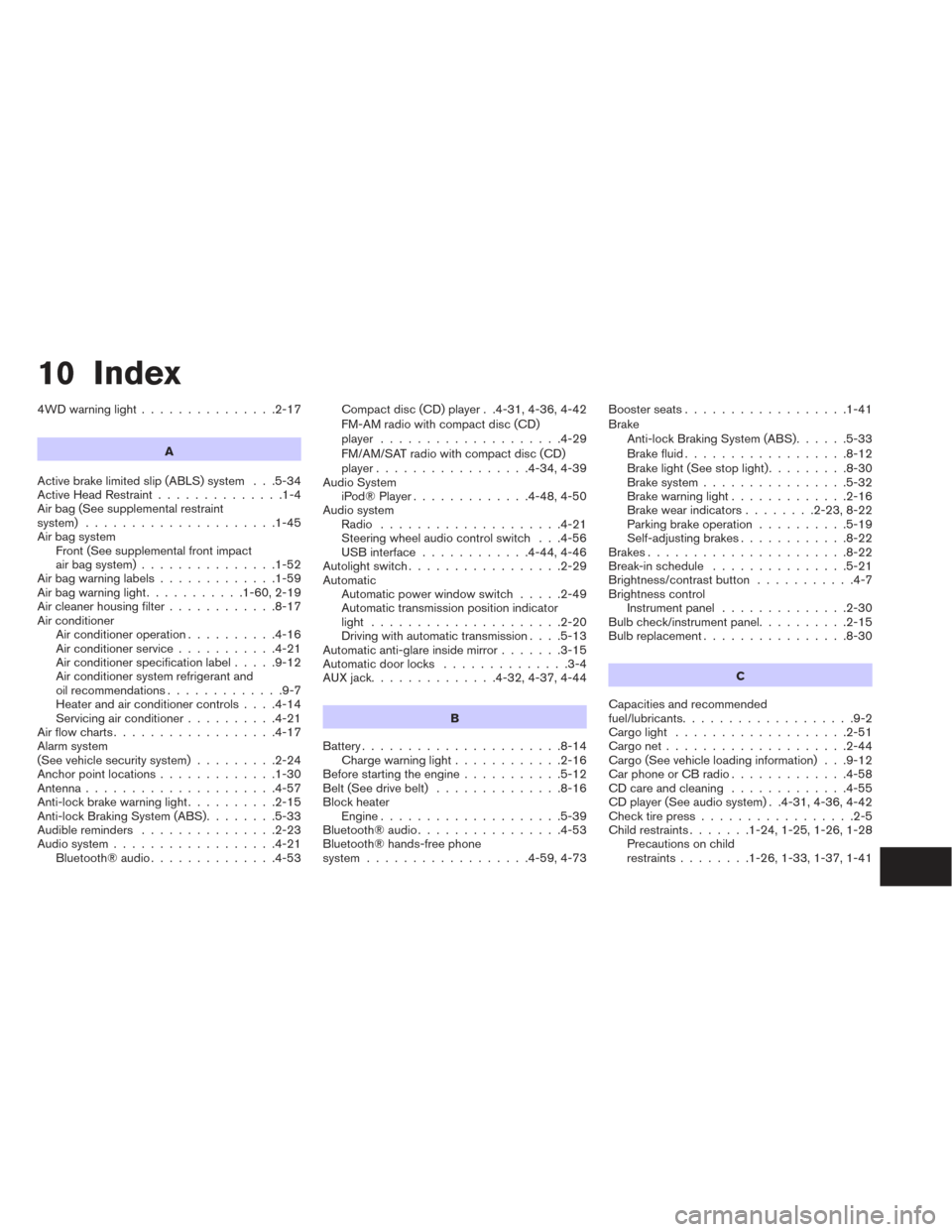
10 Index
4WDwarninglight...............2-17A
Active brake limited slip (ABLS) system . . .5-34
Active Head Restraint ..............1-4
Air bag (See supplemental restraint
system) .....................1-45
Air bag system Front (See supplemental front impact
air bag system) ...............1-52
Airbagwarninglabels.............1-59
Airbagwarninglight...........1-60,2-19
Air cleaner housing filter ............8-17
Air conditioner Air conditioner operation ..........4-16
Air conditioner service ...........4-21
Air conditioner specification label .....9-12
Air conditioner system refrigerant and
oil recommendations .............9-7
Heater and air conditioner controls ....4-14
Servicing air conditioner ..........4-21
Airflowcharts..................4-17
Alarm system
(See vehicle security system) .........2-24
Anchor point locations .............1-30
Antenna.....................4-57
Anti-lock brake warning light ..........2-15
Anti-lock Braking System (ABS) ........5-33
Audible reminders ...............2-23
Audio system ..................4-21
Bluetooth®audio..............4-53 Compact disc (CD) player . .4-31, 4-36, 4-42
FM-AM radio with compact disc (CD)
player ....................4-29
FM/AM/SAT radio with compact disc (CD)
player.................4-34,4-39
Audio System iPod®Player.............4-48,4-50
Audio system Radio ....................4-21
Steering wheel audio control switch . . .4-56
USB interface ............4-44,4-46
Autolight switch .................2-29
Automatic Automatic power window switch .....2-49
Automatic transmission position indicator
light .....................2-20
Driving with automatic transmission ....5-13
Automatic anti-glare inside mirror .......3-15
Automatic door locks ..............3-4
AUXjack..............4-32,4-37,4-44
B
Battery ......................8-14
Charge warning light ............2-16
Before starting the engine ...........5-12
Belt (See drive belt) ..............8-16
Block heater Engine ....................5-39
Bluetooth®audio................4-53
Bluetooth® hands-free phone
system ..................4-59,4-73 Boosterseats..................1-41
Brake
Anti-lock Braking System (ABS) ......5-33
Brakefluid..................8-12
Brakelight(Seestoplight).........8-30
Brake system ................5-32
Brake warning light .............2-16
Brake wear indicators ........2-23,8-22
Parking brake operation ..........5-19
Self-adjusting brakes ............8-22
Brakes ......................8-22
Break-inschedule ...............5-21
Brightness/contrast button ...........4-7
Brightness control Instrument panel ..............2-30
Bulb check/instrument panel ..........2-15
Bulbreplacement................8-30
C
Capacities and recommended
fuel/lubricants ...................9-2
Cargolight ...................2-51
Cargonet....................2-44
Cargo (See vehicle loading information) . . .9-12
Car phone or CB radio .............4-58
CD care and cleaning .............4-55
CD
player (See audio system) . .4-31, 4-36, 4-42
Check tire press .................2-5
Child restraints .......1-24,1-25,1-26,1-28
Precautions on child
restraints ........1-26,1-33,1-37,1-41
Page 377 of 384
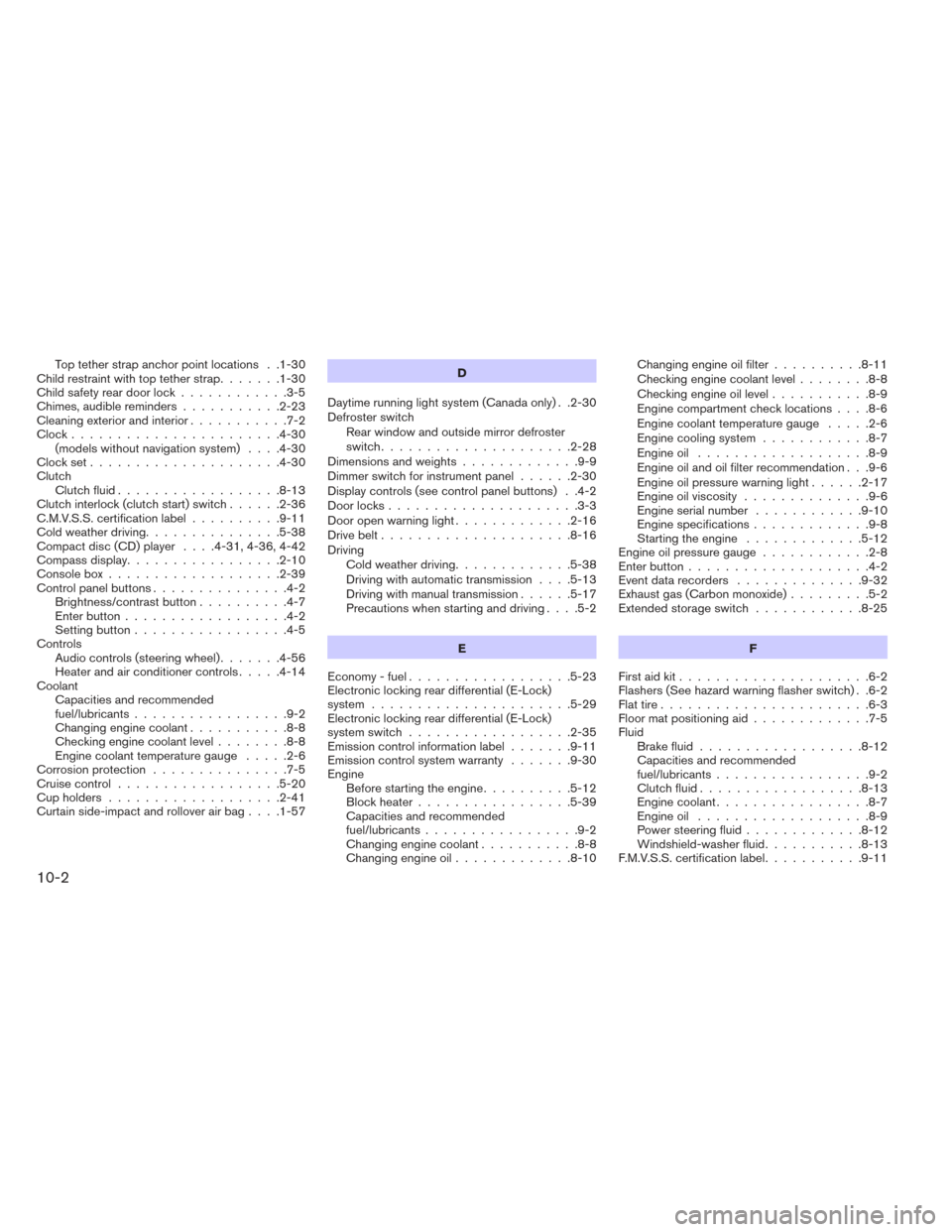
Top tether strap anchor point locations . .1-30
Child restraint with top tether strap .......1-30
Child safety rear door lock ............3-5
Chimes, audible reminders ...........2-23
Cleaning exterior and interior ...........7-2
Clock.......................4-30 (models without navigation system) ....4-30
Clockset.....................4-30
Clutch Clutch fluid ..................8-13
Clutch interlock (clutch start) switch ......2-36
C.M.V.S.S. certification label ..........9-11
Cold weather driving ...............5-38
Compact disc (CD) player ....4-31,4-36,4-42
Compass display .................2-10
Consolebox...................2-39
Control panel buttons ...............4-2
Brightness/contrast button ..........4-7
Enterbutton..................4-2
Setting button .................4-5
Controls Audiocontrols(steeringwheel).......4-56
Heater and air conditioner controls .....4-14
Coolant Capacities and recommended
fuel/lubricants .................9-2
Changing engine coolant ...........8-8
Checking engine coolant level ........8-8
Engine coolant temperature gauge .....2-6
Corrosionprotection ...............7-5
Cruisecontrol..................5-20
Cupholders...................2-41
Curtainside-impactandrolloverairbag....1-57 D
Daytime running light system (Canada only) . .2-30
Defroster switch Rear window and outside mirror defroster
switch.....................2-28
Dimensionsandweights.............9-9
Dimmer switch for instrument panel ......2-30
Display controls (see control panel buttons) . .4-2
Door locks .....................3-3
Door open warning light .............2-16
Drive belt .....................8-16
Driving Cold weather driving .............5-38
Driving with automatic transmission ....5-13
Driving with manual transmission ......5-17
Precautions when starting and driving ....5-2
E
Economy - fuel ..................5-23
Electronic locking rear differential (E-Lock)
system ......................5-29
Electronic locking rear differential (E-Lock)
system switch ..................2-35
Emission control information label .......9-11
Emission control system warranty .......9-30
Engine Before starting the engine ..........5-12
Block heater .................5-39
Capacities and recommended
fuel/lubricants .................9-2
Changingenginecoolant...........8-8
Changingengineoil.............8-10 Changing engine oil filter
..........8-11
Checking engine coolant level ........8-8
Checking engine oil level ...........8-9
Engine compartment check locations ....8-6
Engine coolant temperature gauge .....2-6
Engine cooling system ............8-7
Engine oil ...................8-9
Engine oil and oil filter recommendation . . .9-6
Engine oil pressure warning light ......2-17
Engine oil viscosity ..............
9-6
Engine serial number ............9-10
Engine specifications .............9-8
Starting the engine .............5-12
Engine oil pressure gauge ............2-8
Enterbutton....................4-2
Eventdatarecorders ..............9-32
Exhaustgas(Carbonmonoxide).........5-2
Extended storage switch ............8-25
F
First aid kit .....................6-2
Flashers (See hazard warning flasher switch) . .6-2
Flat tire .......................6-3
Floor mat positioning aid .............7-5
Fluid Brake fluid ..................8-12
Capacities and recommended
fuel/lubricants .................9-2
Clutchfluid..................8-13
Engine coolant .................8-7
Engine oil ...................8-9
Power steering fluid .............8-12
Windshield-washer fluid ...........8-13
F.M.V.S.S. certification label ...........9-11
10-2
Page 379 of 384
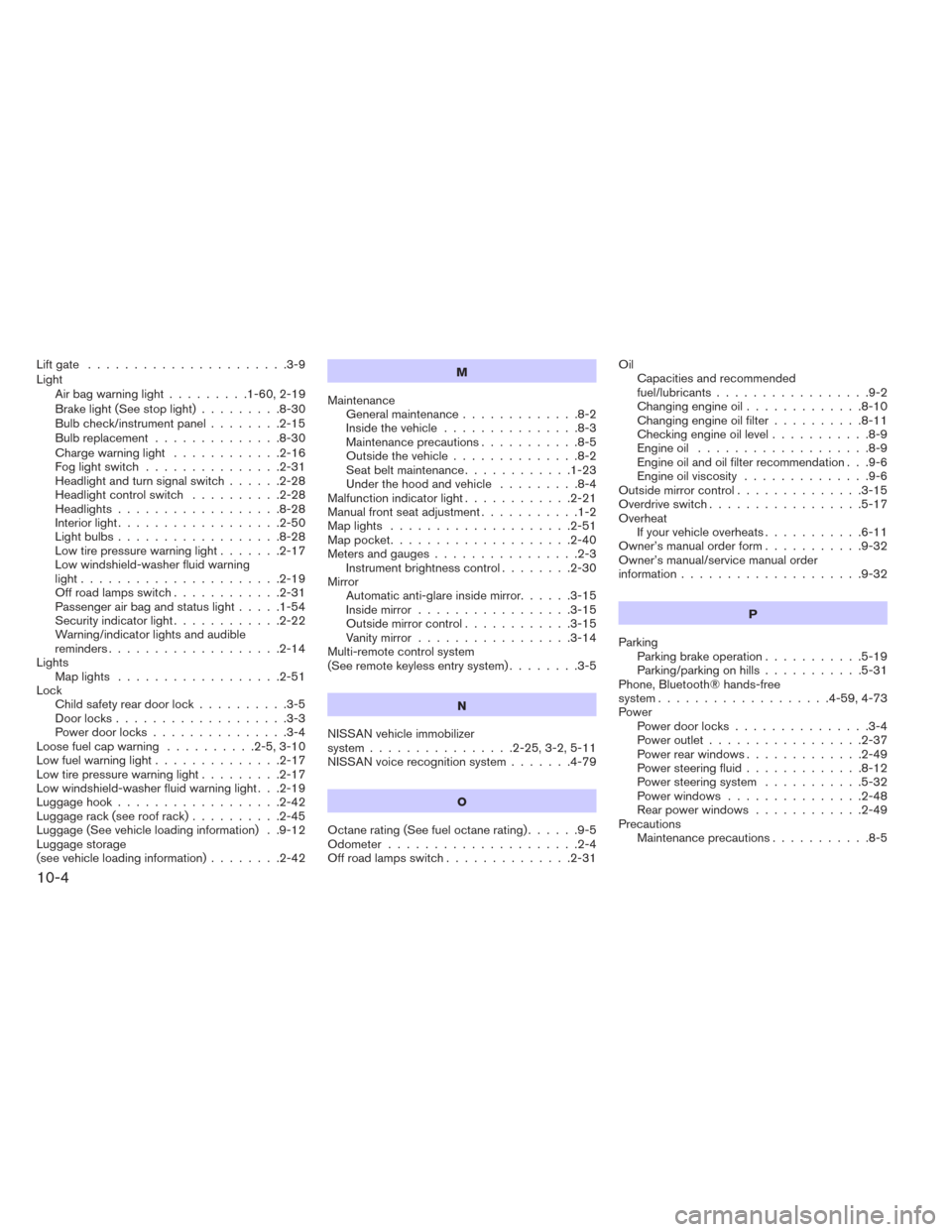
Liftgate ......................3-9
LightAirbagwarninglight.........1-60,2-19
Brakelight(Seestoplight).........8-30
Bulb check/instrument panel ........2-15
Bulb replacement ..............8-30
Chargewarninglight ............2-16
Foglightswitch ...............2-31
Headlight and turn signal switch ......2-28
Headlightcontrolswitch ..........2-28
Headlights..................8-28
Interiorlight..................2-50
Lightbulbs..................8-28
Low tire pressure warning light .......2-17
Low windshield-washer fluid warning
light......................2-19
Offroadlampsswitch............2-31
Passenger air bag and status light .....1-54
Security indicator light ............2-22
Warning/indicator lights and audible
reminders ...................2-14
Lights Maplights ..................2-51
Lock Child safety rear door lock ..........3-5
Door locks ...................3-3
Power door locks ...............3-4
Loose fuel cap warning ..........2-5,3-10
Lowfuelwarninglight..............2-17
Low tire pressure warning light .........2-17
Low windshield-washer fluid warning light . . .2-19
Luggage hook ..................2-42
Luggage rack (see roof rack) ..........2-45
Luggage (See vehicle loading information) . .9-12
Luggage storage
(seevehicleloadinginformation)........2-42 M
Maintenance Generalmaintenance.............8-2
Insidethevehicle...............8-3
Maintenance precautions ...........8-5
Outside the vehicle ..............8-2
Seatbeltmaintenance............1-23
Underthehoodandvehicle .........8-4
Malfunction indicator light ............2-21
Manual front seat adjustment ...........1-2
Maplights ....................2-51
Map pocket ....................2-40
Meters and gauges ................2-3
Instrument brightness control ........2-30
Mirror Automatic anti-glare inside mirror ......3-15
Inside mirror .................3-15
Outside mirror control ............3-15
Vanity mirror .................3-14
Multi-remote control system
(See remote keyless entry system) ........3-5
N
NISSAN vehicle immobilizer
system ................2-25,3-2,5-11
NISSAN voice recognition system .......4-79
O
Octane rating (See fuel octane rating) ......9-5
Odometer .....................2-4
Offroadlampsswitch..............2-31 Oil
Capacities and recommended
fuel/lubricants .................9-2
Changing engine oil .............8-10
Changing engine oil filter ..........8-11
Checking engine oil level ...........8-9
Engine oil ...................8-9
Engine oil and oil filter recommendation . . .9-6
Engine oil viscosity ..............9-6
Outside mirror control ..............3-15
Overdrive switch .................5-17
Overheat If your vehicle overheats ...........6-11
Owner’s manual order form ...........9-32
Owner’s manual/service manual order
information ....................9-32
P
Parking Parking
brake operation ...........5-19
Parking/parking on hills ...........5-31
Phone, Bluetooth® hands-free
system ...................4-59,4-73
Power Power door locks ...............3-4
Power outlet .................2-37
Power rear windows .............2-49
Power steering fluid .............8-12
Power steering system ...........5-32
Power windows ...............2-48
Rear power windows ............2-49
Precautions Maintenanceprecautions...........8-5
10-4
Page 380 of 384
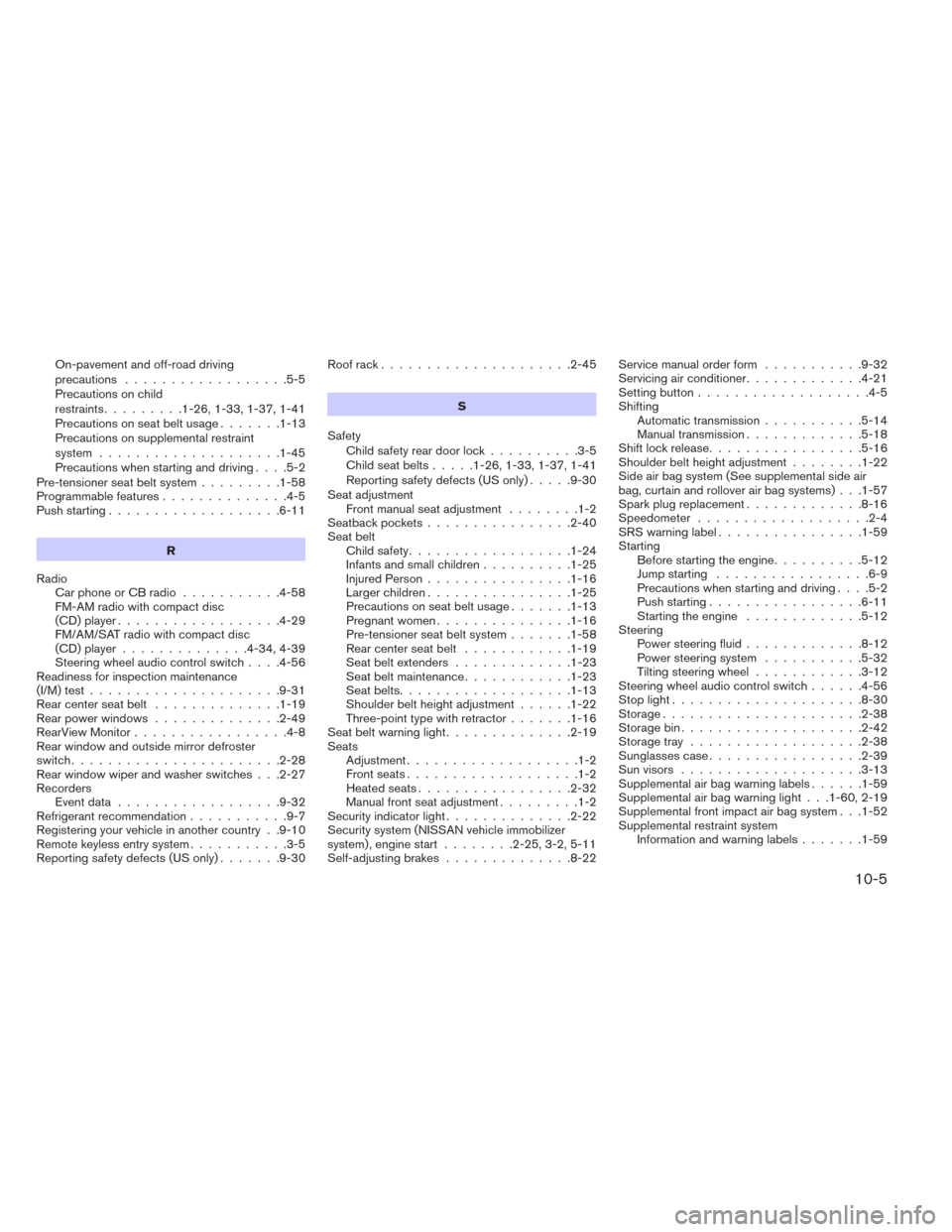
On-pavement and off-road driving
precautions..................5-5
Precautions on child
restraints .........1-26,1-33,1-37,1-41
Precautionsonseatbeltusage.......1-13
Precautions on supplemental restraint
system ....................1-45
Precautions when starting and driving ....5-2
Pre-tensioner seat belt system .........1-58
Programmable features ..............4-5
Push starting ...................6-11
R
Radio Car phone or CB radio ...........4-58
FM-AM radio with compact disc
(CD) player ..................4-29
FM/AM/SAT radio with compact disc
(CD) player ..............4-34,4-39
Steering wheel audio control switch ....4-56
Readiness for inspection maintenance
(I/M) test .....................9-31
Rearcenterseatbelt ..............1-19
Rear power windows ..............2-49
RearViewMonitor.................4-8
Rear window and outside mirror defroster
switch .......................2-28
Rear window wiper and washer switches . . .2-27
Recorders Eventdata..................9-32
Refrigerant recommendation ...........9-7
Registering your vehicle in another country . .9-10
Remote keyless entry system ...........3-5
Reporting safety defects (US only) .......9-30Roof rack
.....................2-45
S
Safety Child safety rear door lock ..........3-5
Childseatbelts.....1-26,1-33,1-37,1-41
Reporting safety defects (US only) .....9-30
Seat adjustment Frontmanualseatadjustment ........1-2
Seatback pockets ................2-40
Seat belt Child safety ..................1-24
Infants and small children ..........1-25
Injured Person ................1-16
Largerchildren................1-25
Precautions on seat belt usage .......1-13
Pregnant women ...............1-16
Pre-tensioner seat belt system .......1-58
Rear center seat belt ............1-19
Seatbeltextenders .............1-23
Seatbeltmaintenance............1-23
Seatbelts...................1-13
Shoulder belt height adjustment ......1-22
Three-point type with retractor .......1-16
Seat belt warning light ..............2-19
Seats Adjustment ...................1-2
Frontseats...................1-2
Heatedseats.................2-32
Manual front seat adjustment .........1-2
Security indicator light ..............2-22
Security system (NISSAN vehicle immobilizer
system) , engine start ........2-25,3-2,5-11
Self-adjusting brakes ..............8-22 Service manual order form
...........9-32
Servicing air conditioner .............4-21
Setting button ...................4-5
Shifting Automatic transmission ...........5-14
Manual transmission .............5-18
Shiftlockrelease.................5-16
Shoulder belt height adjustment ........1-22
Side air bag system (See supplemental side air
bag, curtain and rollover air bag systems) . . .1-57
Spark plug replacement .............8-16
Speedometer ...................2-4
SRSwarninglabel................1-59
Starting Before starting the engine ..........5-12
Jump starting .................
6-9
Precautions when starting and driving ....5-2
Push starting .................6-11
Starting the engine .............5-12
Steering Power steering fluid .............8-12
Power steering system ...........5-32
Tilting steering wheel ............3-12
Steering wheel audio control switch ......4-56
Stoplight.....................8-30
Storage......................2-38
Storagebin....................2-42
Storage tray ...................2-38
Sunglasses case .................2-39
Sun visors ....................3-13
Supplemental air bag warning labels ......1-59
Supplemental air bag warning light . . .1-60, 2-19
Supplemental front impact air bag system . . .1-52
Supplemental restraint system Information and warning labels .......1-59
10-5
Page 381 of 384
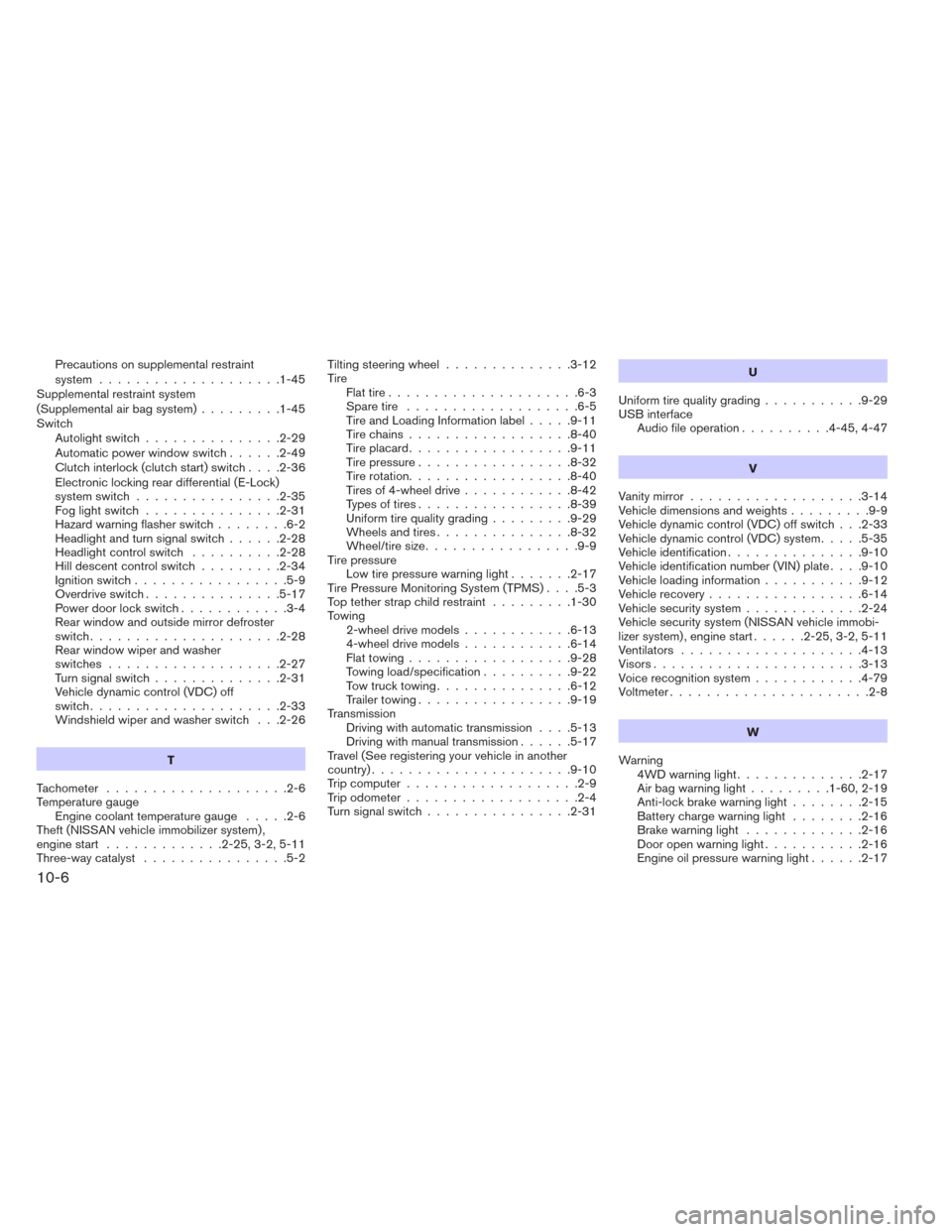
Precautions on supplemental restraint
system ....................1-45
Supplemental restraint system
(Supplemental air bag system) .........1-45
Switch Autolightswitch...............2-29
Automatic power window switch ......2-49
Clutch interlock (clutch start) switch ....2-36
Electronic locking rear differential (E-Lock)
systemswitch................2-35
Foglightswitch ...............2-31
Hazard warning flasher switch ........6-2
Headlight and turn signal switch ......2-28
Headlightcontrolswitch ..........2-28
Hill descent control switch .........2-34
Ignition switch .................5-9
Overdrive switch ...............5-17
Power door lock switch ............3-4
Rear window and outside mirror defroster
switch.....................2-28
Rear window wiper and washer
switches ...................2-27
Turnsignalswitch..............2-31
Vehicle dynamic control (VDC) off
switch.....................2-33
Windshield wiper and washer switch . . .2-26
T
Tachometer ....................2-6
Temperature gauge Engine coolant temperature gauge .....2-6
Theft (NISSAN vehicle immobilizer system) ,
engine start .............2-25,3-2,5-11
Three-way catalyst ................5-2 Tilting steering wheel
..............3-12
Tire Flat tire .....................6-3
Spare tire ...................6-5
Tire and Loading Information label .....9-11
Tirechains..................8-40
Tireplacard..................9-11
Tire pressure .................8-32
Tire rotation..................8-40
Tires of 4-wheel drive ............8-42
Types of tires .................8-39
Uniform tire quality grading .........9-29
Wheels and tires ...............8-32
Wheel/tire size .................9-9
Tire pressure Low tire pressure warning light .......2-17
Tire Pressure Monitoring System (TPMS) ....5-3
Top tether strap child restraint .........1-30
Towing 2-wheel drive models ............6-13
4-wheel drive models ............6-14
Flattowing..................9-28
Towing load/specification ..........9-22
Towtrucktowing...............6-12
Trailer towing .................9-19
Transmission Driving with automatic transmission ....5-13
Driving with manual transmission ......5-17
Travel (See registering your vehicle in another
country) ......................9-10
Trip computer ...................2-9
Trip odometer ...................2-4
Turn signal switch ................2-31 U
Uniform tire quality grading ...........9-29
USB interface Audio file operation ..........4-45,4-47
V
Vanity mirror ...................3-14
Vehicledimensionsandweights.........9-9
Vehicle dynamic control (VDC) off switch . . .2-33
Vehicle dynamic control (VDC) system .....5-35
Vehicle identification ...............9-10
Vehicle identification number (VIN) plate ....9-10
V
ehicleloadinginformation...........9-12
Vehicle recovery .................6-14
Vehicle security system .............2-24
Vehicle security system (NISSAN vehicle immobi-
lizer system) , engine start ......2-25,3-2,5-11
Ventilators ....................4-13
Visors.......................3-13
Voice recognition system ............4-79
Voltmeter......................2-8
W
Warning 4WDwarninglight..............2-17
Airbagwarninglight.........1-60, 2-19
Anti-lock brake warning light ........2-15
Battery charge warning light ........2-16
Brake warning light .............2-16
Door open warning light ...........2-16
Engine oil pressure warning light ......2-17
10-6